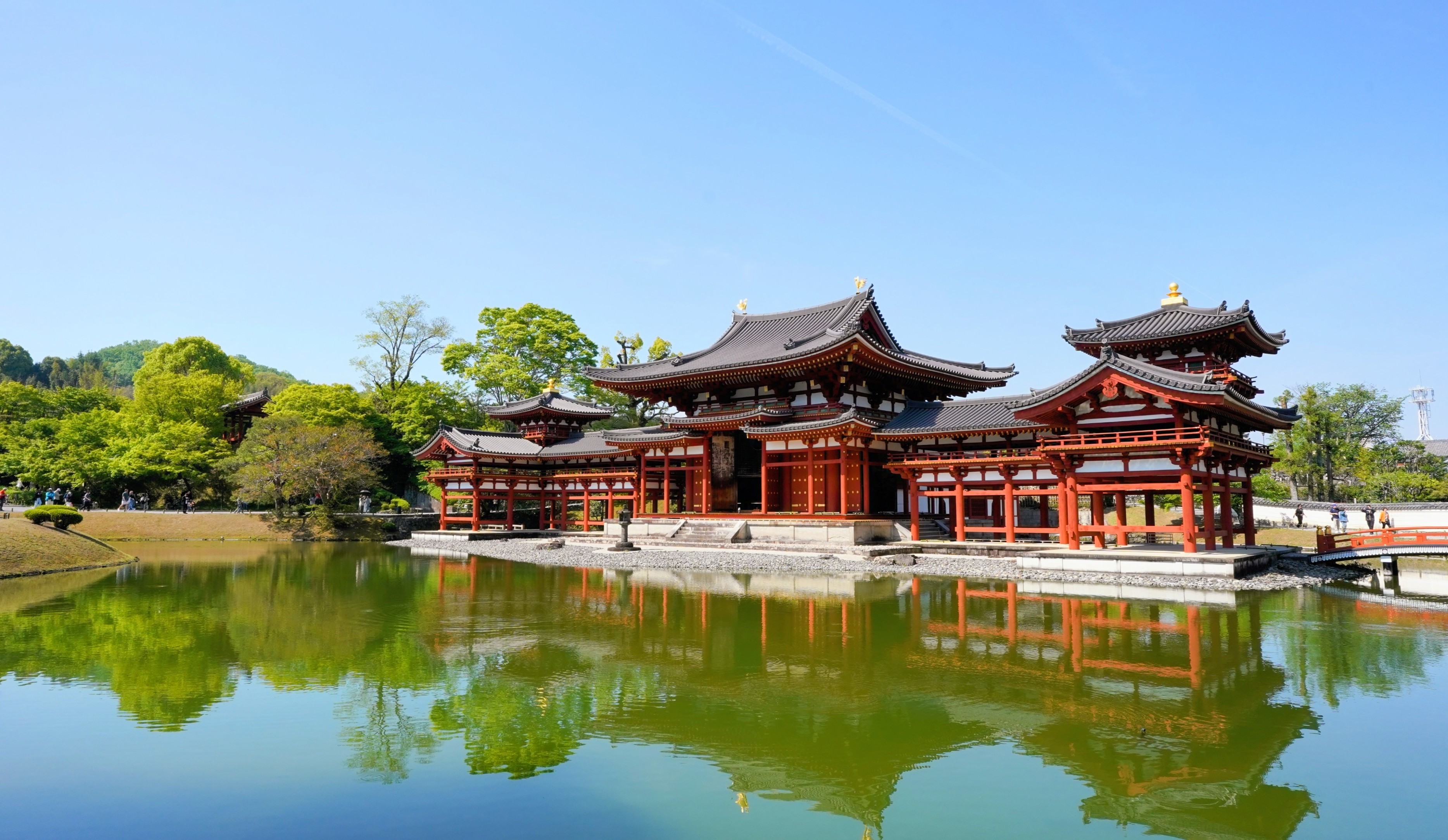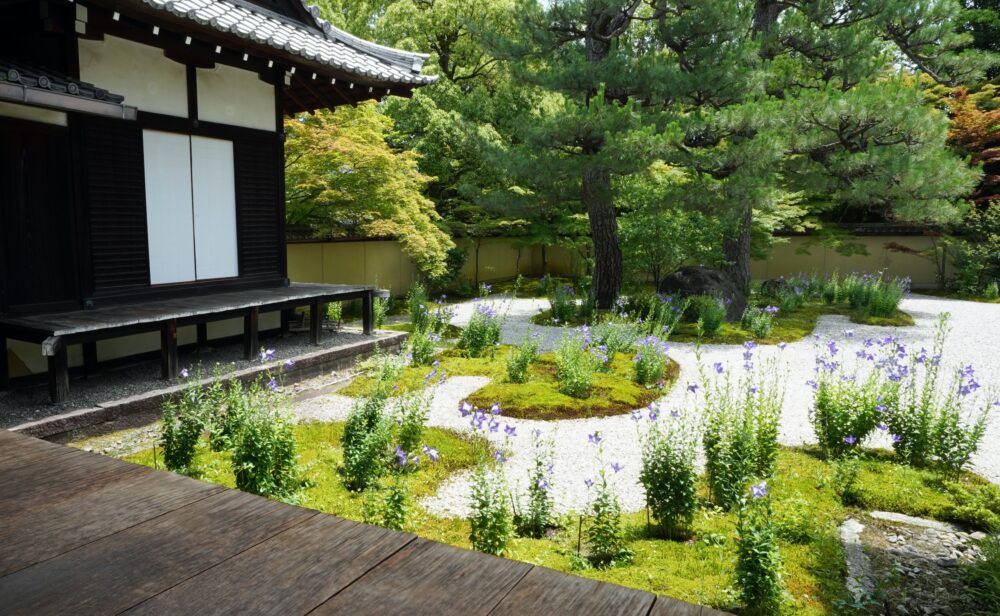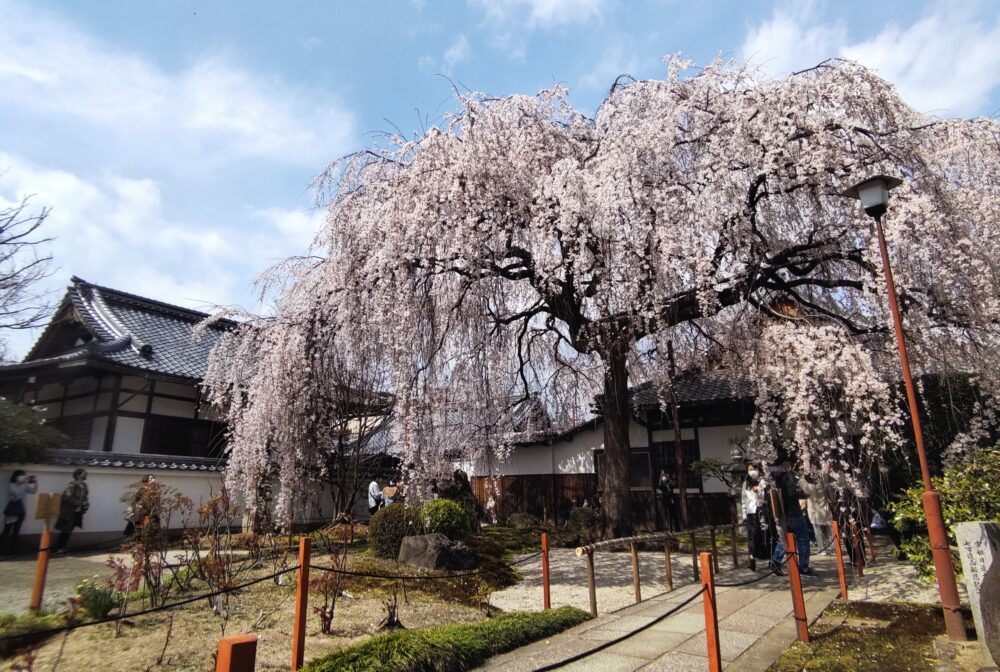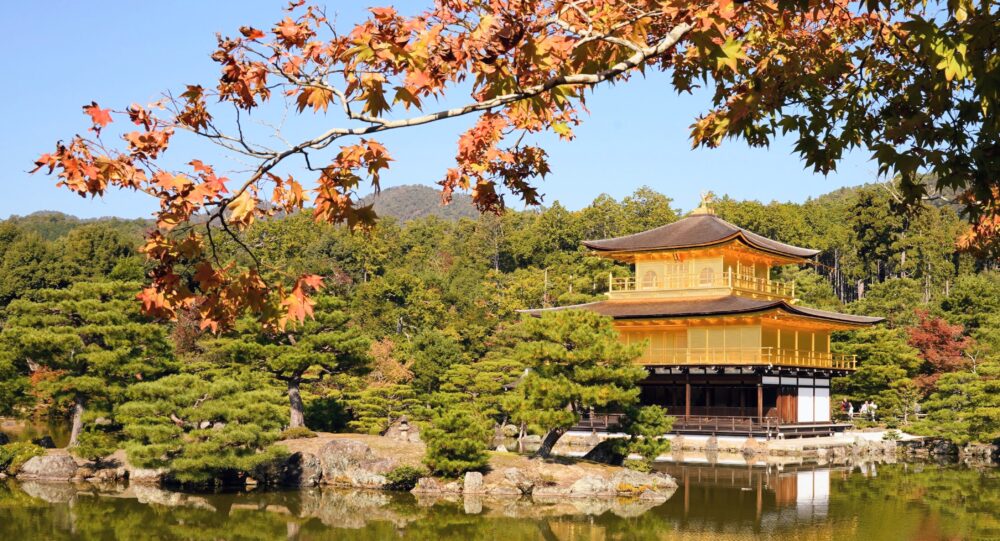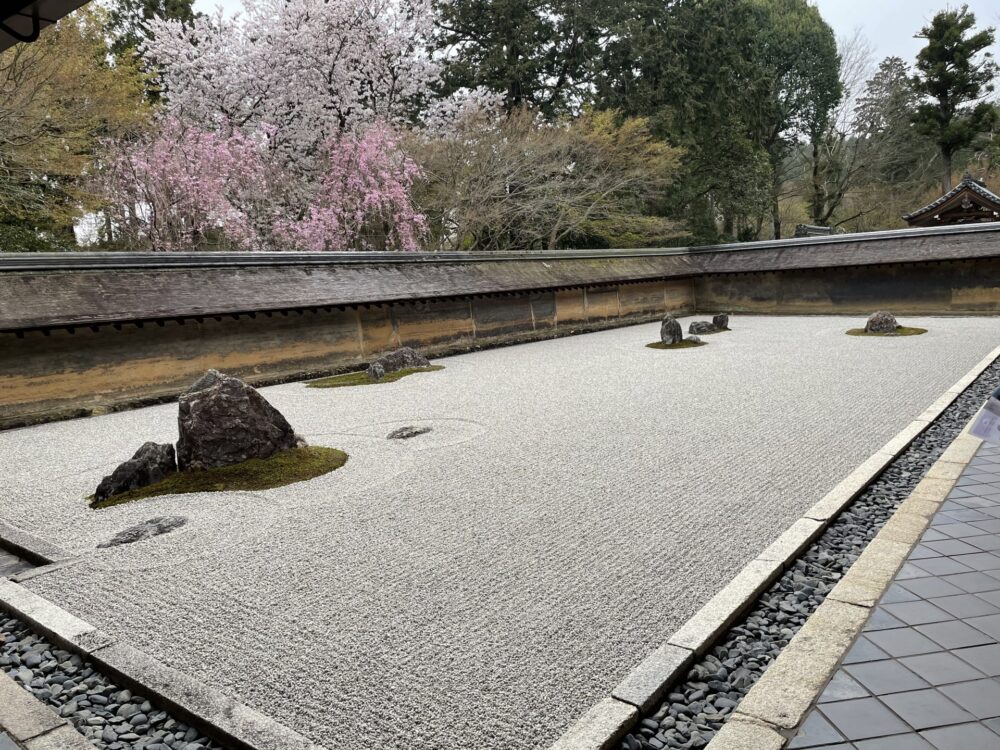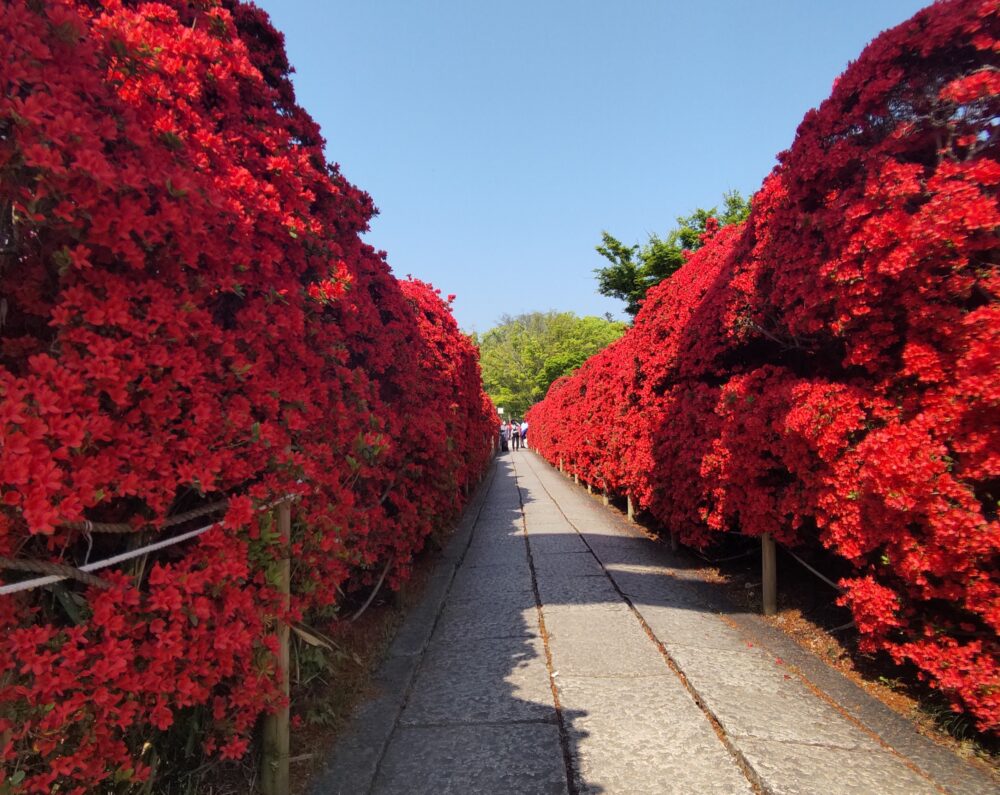Heian Jingu Shrine | All that you should know before Visiting
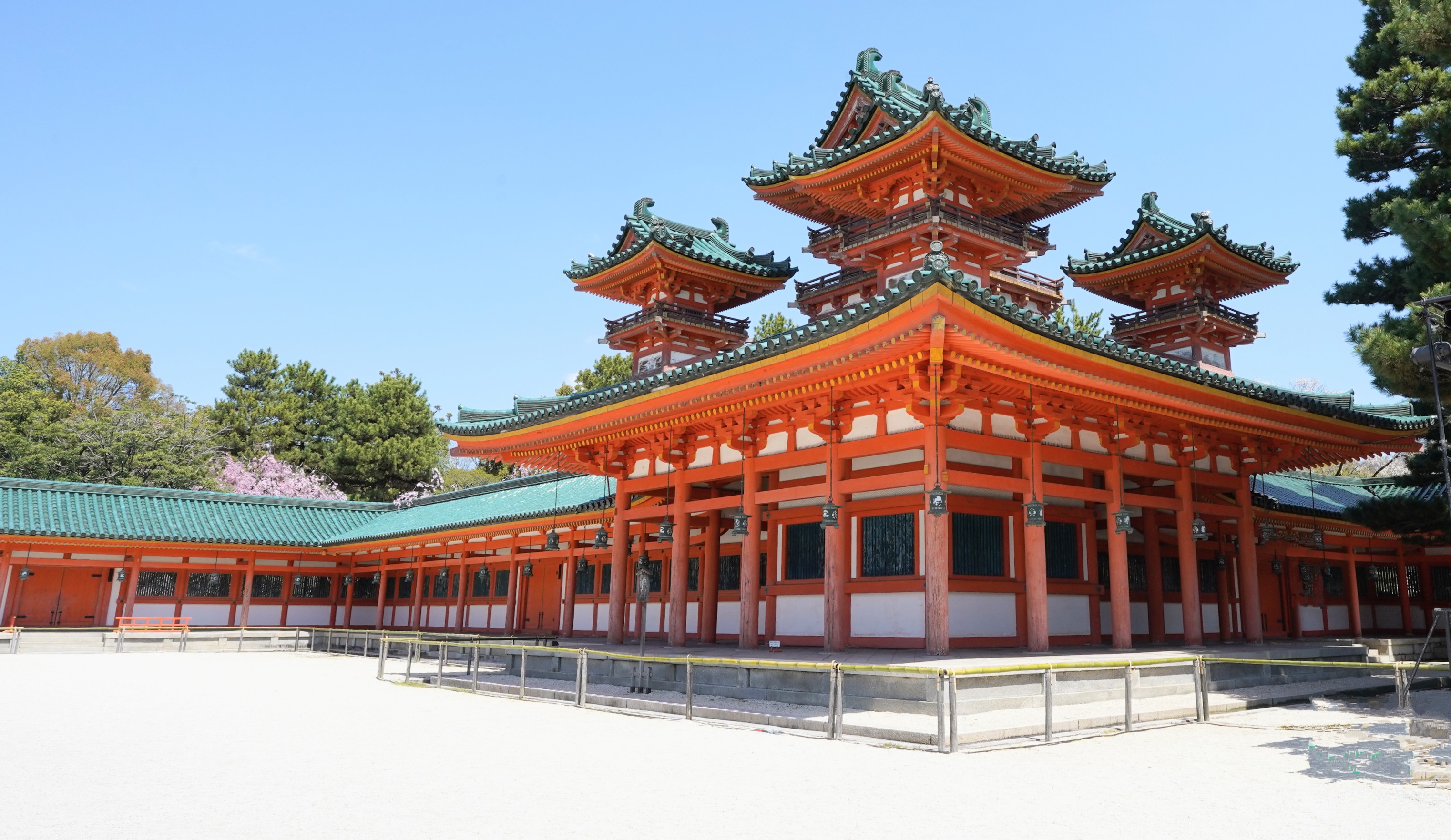
The Heian Jingu Shrine is widely known as a representative shrine in Kyoto, showing the culmination of 1,000 years of architectural techniques since the city was the capital. The shrine buildings are constructed to resemble those of the Heian period, and the surrounding gardens, composed of four distinct sections, are truly magnificent.
History
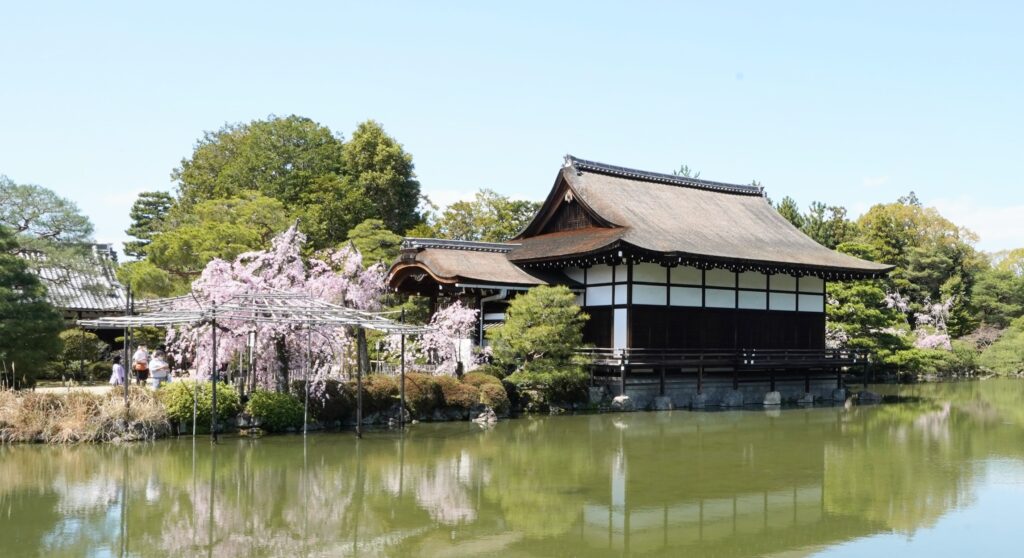
In 1868, when the capital was moved from Kyoto to Tokyo and Emperor Meiji resided there, Kyoto experienced a significant decline in population and economy, dealing a severe blow to its citizens. To revitalize the historic capital, the Heian Shrine was established in 1895 to commemorate the 1,100th anniversary of the capital’s relocation to Heian-kyo.
The shrine’s main hall, outer hall, and gate were constructed, and Emperor Kanmu, the 50th emperor to move the capital to Kyoto, was enshrined. In 1940, after the death of Emperor Komei, the last emperor to reside in the Kyoto Imperial Palace, his divine spirit was also enshrined there.
This led to the construction of additional buildings such as the Main Sanctuary, the Kagura Hall, and the Office, as well as the renovation of the Main Hall.
Buildings
The architecture of the Heian Shrine is based on the design of the great state palace of the Heian period (794-1185), giving visitors a glimpse of the grandeur of ancient Kyoto.
Daigokuden Hall
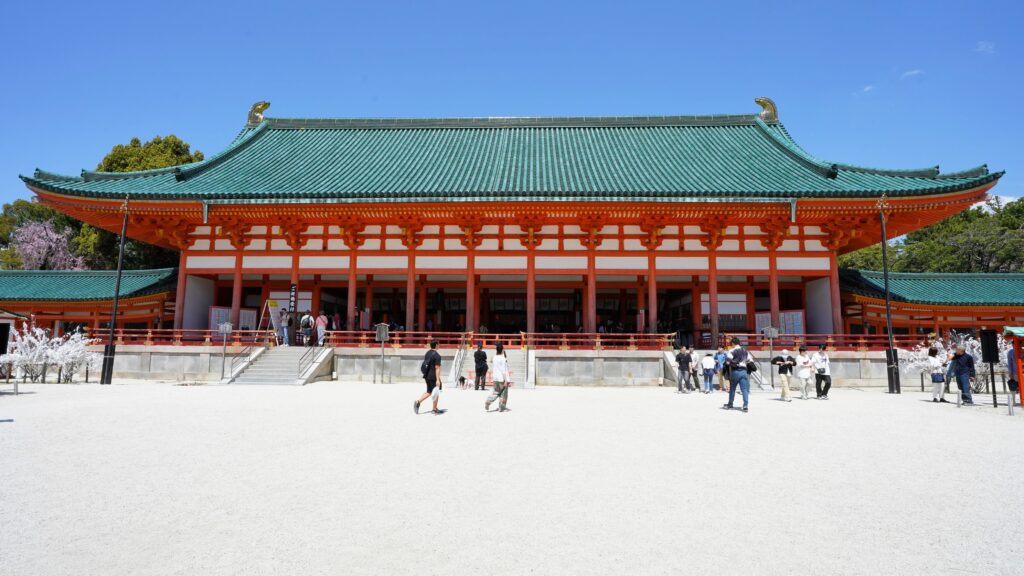
The Daigokuden Hall is an eight-fifths scale replica of the great state hall of the ancient Heian Palace, where emperors held state affairs and important ceremonies such as coronations. Its distinctive features include vermilion columns and green glazed tiles. With an area of 4348 ft2 (403 m2), it is the largest building in the Heian Shrine.
Otemon Gate
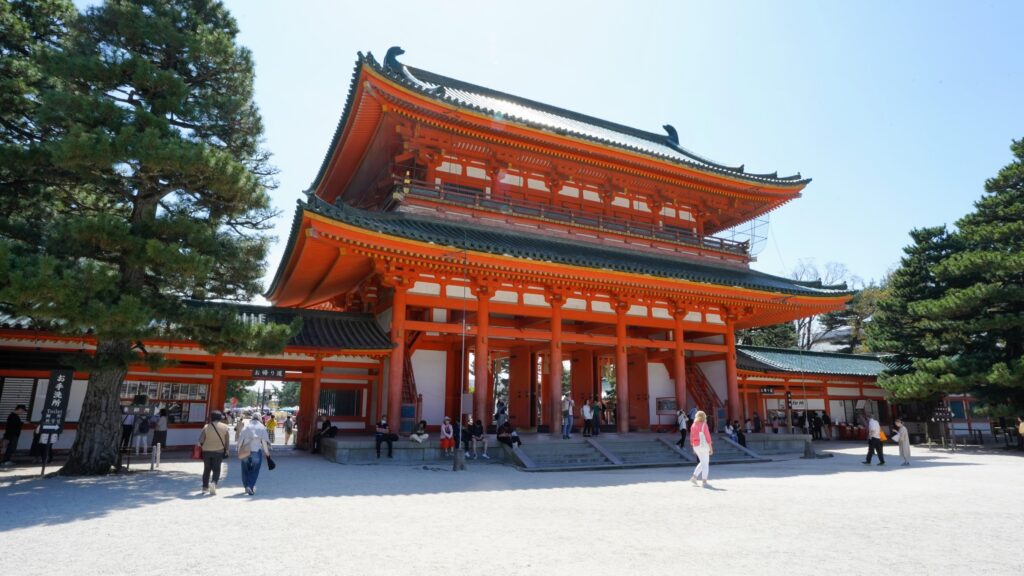
The Otenmon Gate is a reconstruction of the grand entrance to the Chodoin, the central government offices of the Heian Palace. This imposing gate has a two-story structure and is adorned with vibrant vermilion columns and elegant green glazed tiles. Located at the southern end of the Heian Shrine, it serves as the main entrance to the shrine.
Kaguraden Hall
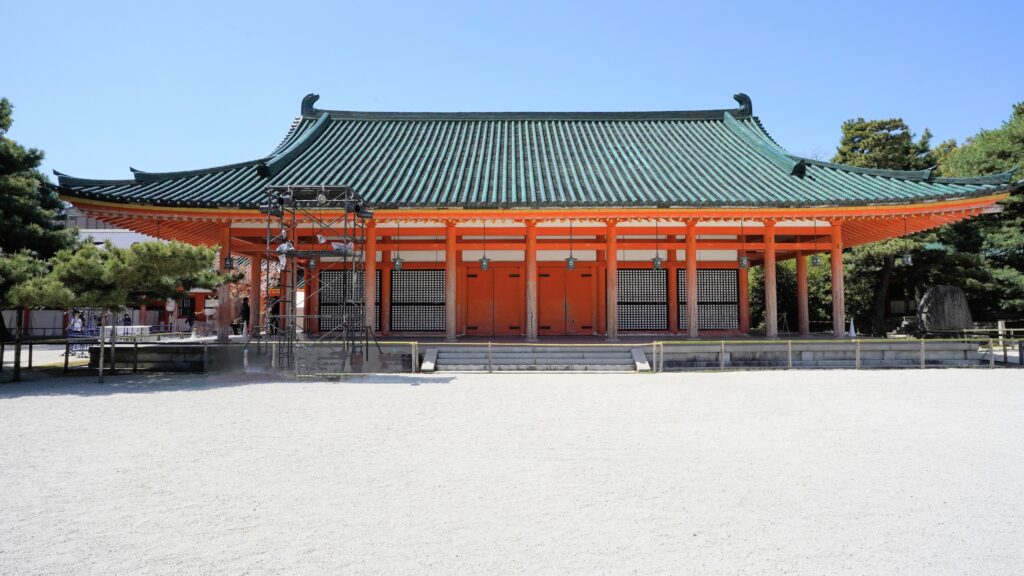
The Kaguraden Hall, a structure located on the east side of the South Inner Garden, serves as a stage for shrine maidens to perform traditional sacred dances.
Torii Gate
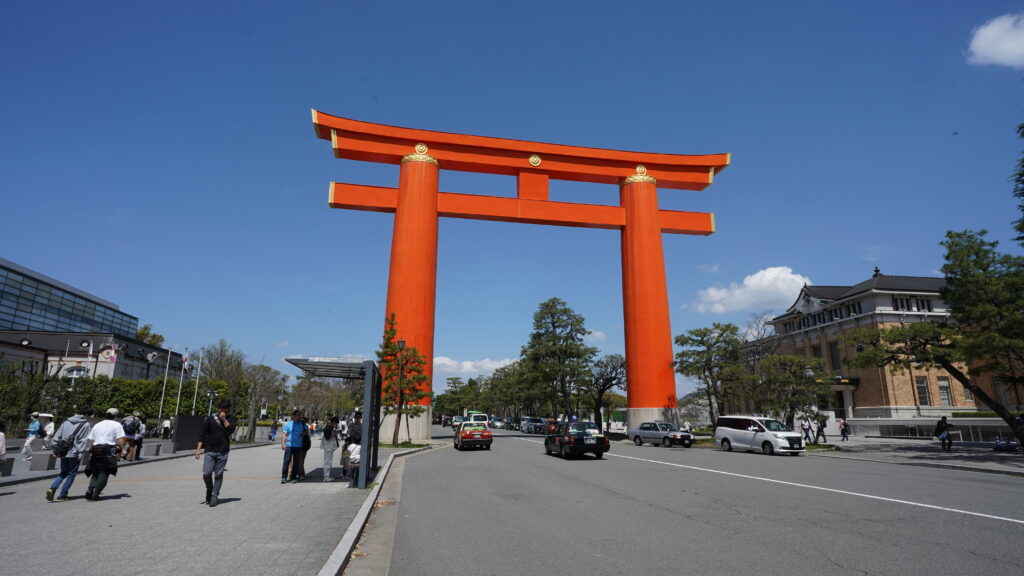
Torii Gate is the first gate of the Heian Shrine, this vermilion Torii stands about 980ft(300m) south of the Otenmon Gate. Measuring 78ft(24m) in height and 59ft(18m) in width, it is the largest torii in Kyoto.
Shin-en Garden
Heian Shrine has a magnificent garden designed by the renowned landscape designer Jihei Ogawa VII, who also created the gardens of the Murinan and Maruyama Park. Encircling the shrine, this expansive pond and stream garden covers an area of about 8.2 acre (33000m2) and showcases the beauty of the four seasons. The garden is divided into four sections: South, West, East, and Central.
Minami Shin-en(South Garden)
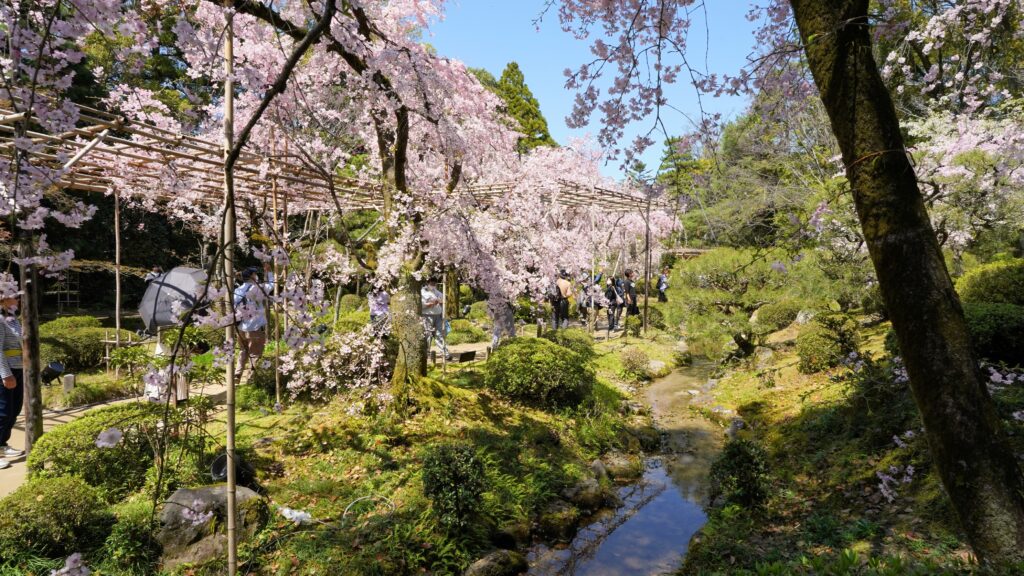
Minami Shin-en, the entrance to the entire garden complex, is particularly famous for its weeping cherry blossoms, which bloom beautifully in spring. Also known as the “Heian Garden,” it features winding streams and plants mentioned in classic Japanese literature such as “The Tale of Genji,” “The Pillow Book,” and the “Kokin Wakashu,” reflecting the garden design popular during the Heian period. A retired Kyoto City Tram is also on display in a corner of the garden.
Nishi Shin-en (West Garden)
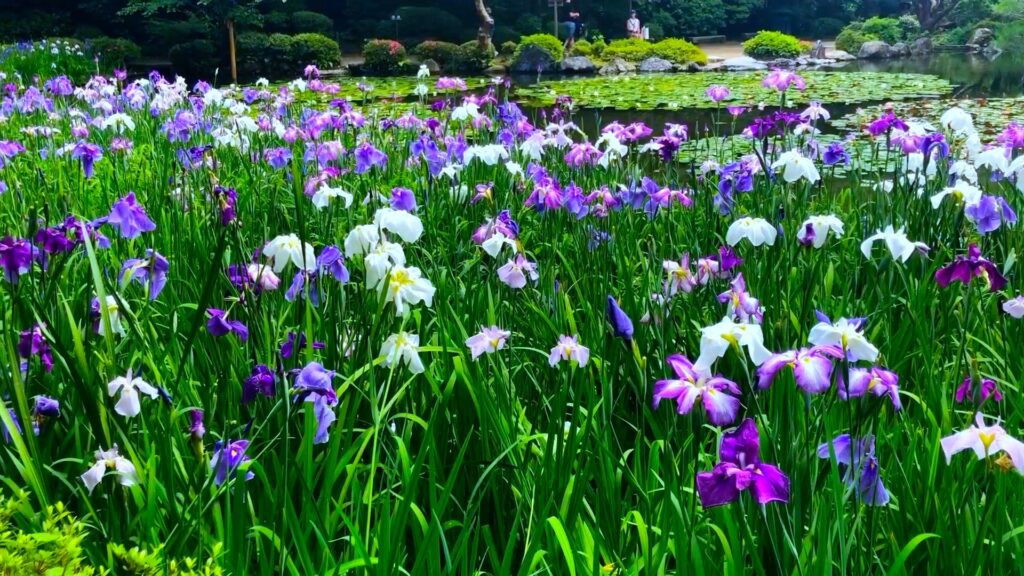
The Nishi Shin-en features a 6000yd2(5000m2) pond, known as Byakko-ike, surrounded by a variety of aquatic plants.The garden is famous for its stunning display of irises in early summer, with some 200 species and 2,000 plants adorning the banks of the pond from late May to late June. The garden also features a small island on the western side of the pond and a unique waterfall on its northern edge. The tea house, Tyoshin-tei, perched on a small hill to the southwest, is a historic structure that has stood since the garden was established in 1895.
Naka Shin-en(Middle Garden)
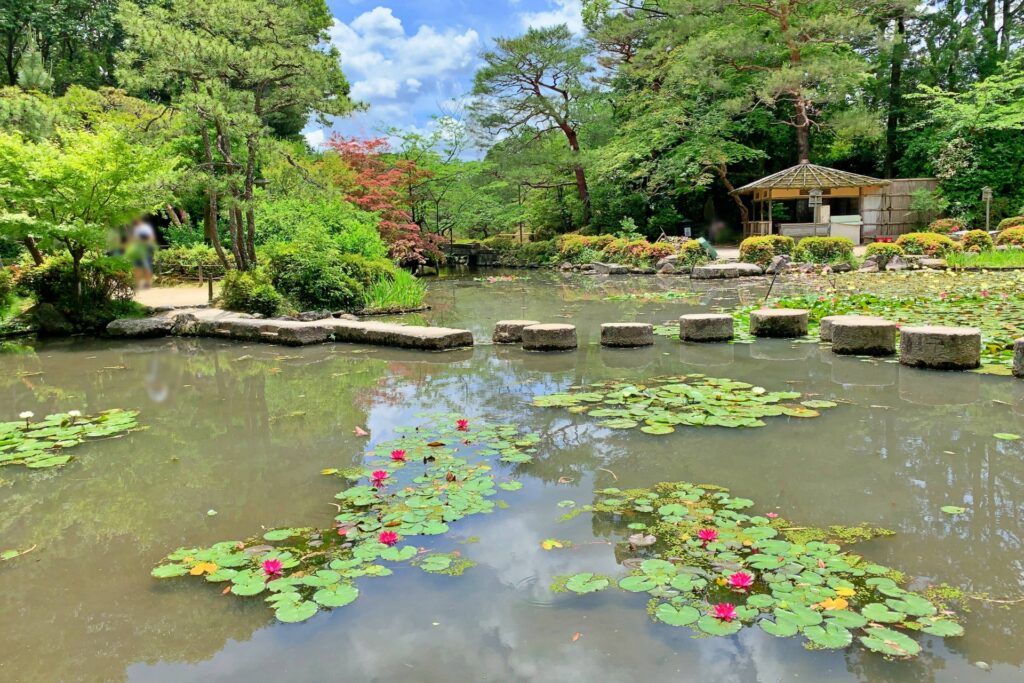
In Naka Shin-en, there is a pond called Soryu-ike. A stepping stone path called Garyu-kyo extends from the northern shore of the pond to Coral Island, where a five-story pagoda stands. Visitors can walk over the stepping stones from the north shore, pass through Coral Island, and reach the south shore. Around the pond is a teahouse called a “chayaya” where you can buy drinks. From early June to early July, the pond is decorated with water lilies and irises.
Higashi Shin-en(East Garden)
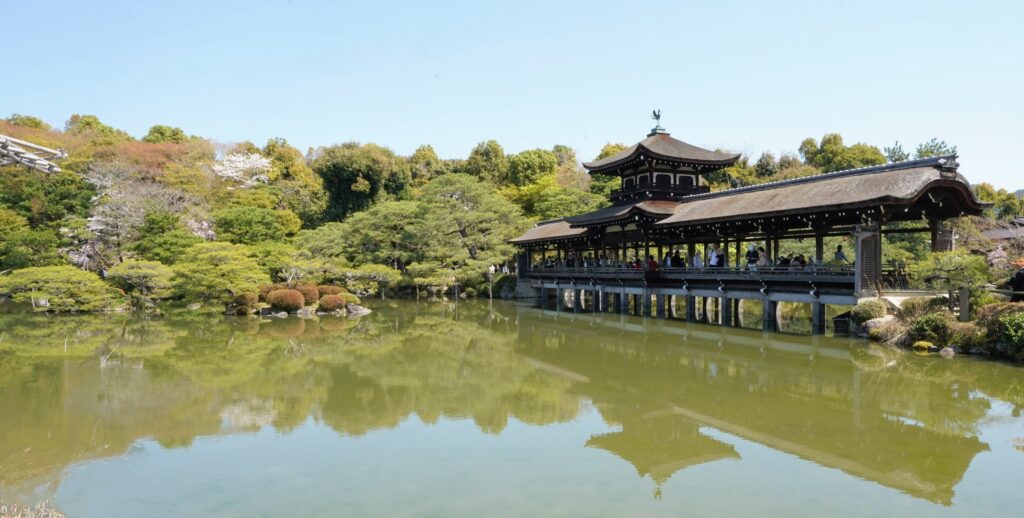
Higashi shin-en has a large pond, Seiho-ike, crossed by Taheikaku, a bridge covered with hinoki bark, and a two-story pavilion topped with a bronze phoenix facing west. The panoramic view from the bridge is breathtaking. On the south side of the pond, you’ll find Crane Island and Turtle Island, symbols of longevity.
Nighttime illumination
The Heian Shrine is famous for its breathtaking night views. Experience the magic of early April when the shrine is specially lit from 6:15 p.m. to 9:00 p.m. Admire the ethereal cherry blossoms bathed in soft light, creating a truly enchanting atmosphere. Concerts featuring Japan’s top musicians are also available to enhance your experience. Upgrade your tickets for an even more memorable night.
Information
Day time
Open Hours
| Period | Time |
|---|---|
| November.1st to February.14th | Shrine Grounds 6:00 a.m.- 5:00 p.m. Shin-en Garden 8:30 a.m. – 5:00 p.m.(Last Entry is at 4:30 p.m.) Reception 7:30 a.m. – 5:00 p.m. |
| February.14th to March.14th | Shrine Grounds 6:00 a.m.- 5:30 p.m. Shin-en Garden 8:30 a.m. – 5:00 p.m.(Last Entry is at 4:30 p.m.) Reception 7:30 a.m. – 5:00 p.m. |
Entrance Fee
Adults : 600 yen
Children : 300 yen
Nighttime Illumination
Open Hours
April.3rd to 7th
| Ticket Types | Time |
|---|---|
| Entrance Ticket to South Garden | 6:15 p.m. – 9:00 p.m. (Last Entry is at 8:30 p.m.) |
| Entrance Ticket to Concert and South Garden | Part 1: 6:40 p.m. – 7:10p.m Part 2: 7:55 p.m. – 8:25 p.m. There will be a complete change of audience between Part 1 and Part 2. The same artists will perform in both parts. |
Entrance Fee
| Ticket Types | Price |
|---|---|
| Entrance Ticket to East Garden (Concert Hall) and South Garden | Adults: 1,500 yen Elementary School Students : 1,300 yen |
| Entrance Ticket to East Garden (Concert Hall) and South Garden | Each Part Adults: 4,000 yen Elementary School Students : 3,500 yen |
Address
97 Okazaki Nishitennocho, Sakyo Ward, Kyoto, 606-8341
Link & Resources
Official Website
Heian Jingu Shrine (English Text)
